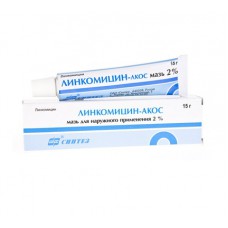Expiration date: 09/2025
Product form, composition and packaging
10 g - tubes aluminum (1) - packs of cardboard.
15 g - tubes aluminum (1) - packs of cardboard.
Clinico-pharmacological group: Antibiotic group lincosamides
Pharmaco-therapeutic group: Antibiotic, lincosamide
Indications
Infectious and inflammatory diseases of severe course caused by microorganisms sensitive to lincomycin, including sepsis, osteomyelitis, septic endocarditis, pneumonia, lung abscess, pleural empyema, wound infection. As a reserve antibiotic in infections caused by strains of Staphylococcus and other gram-positive organisms resistant to penicillin and other antibiotics.
For topical use: purulent-inflammatory diseases of the skin.
ICD-10 codes
Dosage regimen:
When ingestion by adults-500 mg 3-4 times/day or/m - 600 mg 1-2 times / day. B/drip to impose 600 mg in 250 ml isotonic sodium chloride or glucose 2-3 times/day.
Children aged 1 month to 14 years inside-30-60 mg / kg/ day, in / drip administered at a dose of 10-20 mg / kg every 8-12 hours.
When applied topically, apply a thin layer to the affected areas of the skin.
Side effect
From the digestive system: nausea, vomiting, epigastric pain, diarrhoea, glossitis, stomatitis, transient increase in liver transaminases and bilirubin in plasma, with long-term use at high doses may develop pseudomembranous colitis.
From the hematopoietic system: reversible leukopenia, neutropenia, thrombocytopenia.
Allergic reactions: urticaria, exfoliative dermatitis, Quincke's edema, anaphylactic shock.
Effects, due to chemotherapeutic effect: candidiasis.
Local reactions: phlebitis (when in/in the introduction).
With rapid on / in the introduction: reduction in blood PRESSURE, dizziness, General weakness, relaxation of skeletal muscles.
Contraindications to use
Expressed impaired liver and / or kidney function, pregnancy, lactation, hypersensitivity to lincomycin and clindamycin.
Application during pregnancy and breast-feeding
Lincomycin crosses the placental barrier, excreted in breast milk. The use of pregnancy is contraindicated. If necessary, use during lactation should decide the issue of termination of breastfeeding.
Application for violations of liver function
Contraindicated in severe violations of liver function.
If abnormal liver function should be reduced single dose of lincomycin by 1/3 to 1/2 and increase the interval between wvedeniami. Long-term use requires systematic monitoring of liver function.
Application for violations of renal function
Contraindicated in severe violations of kidney function.
If impaired renal function should be reduced single dose of lincomycin by 1/3 to 1/2 and increase the interval between wvedeniami. Long-term use requires systematic monitoring of renal function.
Use in children
Children aged 1 month to 14 years inside-30-60 mg / kg/ day, in / drip administered at a dose of 10-20 mg / kg every 8-12 hours.
Special instruction:
In violation of liver and / or kidney function should reduce a single dose of lincomycin 1/3-1/2 and increase the interval between injections. With prolonged use, systematic control of kidney and liver functions is necessary.
In the case of pseudomembranous colitis lincomycin should be abolished and assign vancomycin or bacitracin.
Drug interaction
When used simultaneously with penicillins, cephalosporins, chloramphenicol or erythromycin, antimicrobial antagonism is possible.
While the use of aminoglycosides possible synergistic action.
While the use of drugs for inhalation anesthesia or peripheral muscle relaxants marked increase neuromuscular blockade, up to the development of apnea.
Taking Antidiarrhoeal drugs reduces the effect of lincomycin.
Pharmaceutical interaction
Pharmacologically incompatible with ampicillin, barbiturates, theophylline, calcium gluconate, heparin and magnesium sulfate.
Lincomycin is incompatible in one syringe or dropper with kanamycin or novobiocin.


